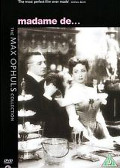
Directed by
Max Ophuls
102 minutes
Rated G
Reviewed by
Bernard Hemingway

Madame De...
Madame De… is one of four films Max Ophüls made towards the end of his life in France. It is a critically highly regarded although probably more for its elegance than dramatic substance.
Set in the late 19th century, Madame De (Danielle Darrieux) is a vain and flirtatious high society wife kept by her aristocratic husband (Charles Boyer) in a marriage of convenience. He philanders, what she does to compensate is not made apparent but presumably shops. When she sells a pair of earring to help settle her debts, a complicated chain of events is set in train that eventually leads to tragedy when they are bought by a diplomat (Vittorio de Sica) who falls for her.
The film is another instance of the director's preoccupation with upper-class morals and etiquette and his favourite time period, the late 19th century. Based on a novella by Louise De Vilmorin, it has an intriguing narrative, structured by the passing of the earrings from hand to hand, and is distinguished by remarkably fluid camera work by Christian Matras, notably in a famous waltz sequence that metaphorically describes the lovers growing attachment to each other, and an elaborate period production design by Jean D'Eaubonne.
The problem with the film is that whilst individually each performance is strong, dramatically the three main characters do not connect. Boyer comes off at best as the urbanely calculating husband but he remains for the most part “hors de concours” whilst the relationship between Darrieux and De Sica is driven by the moral urges of the story rather than anything we see on screen. Whilst intellectually the narrative attains some poignancy, dramatically, the handling of its trajectory is too piecemeal to be emotionally effective or convincing.
Want something different?





